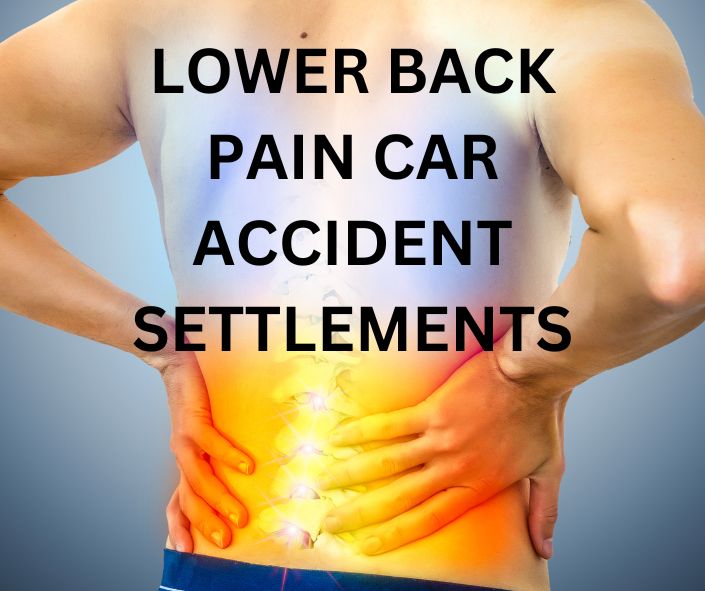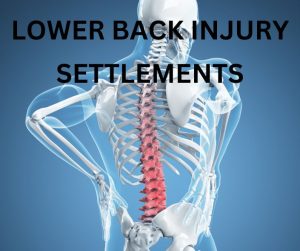Houston Car Accident Lawyers > Articles > Injuries > Maximizing Your Settlement for Lower Back Pain After a Car Accident
Maximizing Your Settlement for Lower Back Pain After a Car Accident

Author: 30klife January 18, 2024
Lower back pain is a common yet often debilitating consequence of car accidents. Its impact can range from mild discomfort to severe disability, affecting not only the physical well-being of individuals but also their ability to work and enjoy life. Navigating the settlement process for lower back injuries incurred in a car accident can be complex and overwhelming. This blog post is designed to guide you through understanding and maximizing your settlement, emphasizing the importance of documenting your injury and its effects on your life. Here is what our auto accident injury lawyers have to say about lower back pain car accident settlements.
Lower Back Pain Car Accident Settlement
Lower back pain following a car accident can stem from various causes such as whiplash, spinal cord damage, or muscle strain. Symptoms might include persistent pain, stiffness, reduced mobility, or even neurological issues like numbness in the legs. It’s crucial to note that lower back pain can sometimes manifest days or even weeks after an accident, making it essential to monitor your health closely post-accident.
Documenting the onset and progression of your symptoms is key. It provides valuable evidence for your claim, especially if the pain emerges or worsens over time. This documentation should include details about the severity of the pain, its impact on your daily activities, and any measures you’ve taken to alleviate it.
Lower Back Pain Medical Evaluation After a Car Accident
Seeking immediate medical attention after a car accident is crucial, not only for your health but also for strengthening your settlement claim. A thorough medical evaluation provides an official record of your injury, which is critical for substantiating your claim.
The most effective medical evidence in lower back pain cases includes medical reports from your doctor, imaging results (like X-rays or MRIs), and records of treatments received. Be sure to keep a detailed record of all medical visits, treatments, and prescriptions, as they serve as proof of the extent and impact of your injury. Additionally, keeping track of any related expenses is vital for calculating your economic damages later.
Calculating Economic and Non-Economic Damages for Lower Back Injuries
Your settlement should cover both economic and non-economic damages. Economic damages are relatively straightforward, encompassing medical expenses, cost of future treatments, and lost wages if your injury affects your ability to work. Non-economic damages, which include pain and suffering, are more subjective and can be calculated using methods like the ‘multiplier’ method, where your economic damages are multiplied by a number based on the severity of your pain and suffering.
Future medical expenses are a significant consideration, especially if your lower back injury requires long-term treatment or rehabilitation. Keeping a detailed account of all your expenses, including projected future costs, is essential in ensuring that your settlement covers both current and future financial impacts.
You should also read “Neck Injury Settlement Guide.”
Legal Considerations and Representation:
Navigating a lower back pain settlement claim can be complex, often necessitating legal expertise. An experienced personal injury attorney can help evaluate your case, gather necessary evidence, and negotiate with insurance companies.
The question of whether to hire a lawyer largely depends on the complexity of your case. For straightforward, minor injury claims, you might manage without legal representation. However, for more severe injuries with substantial medical expenses or disputed liability, having an attorney can be invaluable. They can help ensure that your settlement accurately reflects the true cost of your injury, both financially and emotionally.
Negotiating the Settlement for Lower Back Pain
The negotiation process with insurance companies can be challenging. Insurers often initially offer a settlement lower than what your claim might be worth. It’s crucial not to accept the first offer hastily. A well-negotiated settlement requires understanding the full extent of your damages, backed by solid evidence and effective communication of your claim’s validity.
Insurance companies typically calculate offers based on your medical expenses, lost wages, the severity of your injury, and their assessment of your pain and suffering. Understanding how these calculations are made can help you counter lowball offers and negotiate for a settlement that truly compensates for your injury.
Lower Back Injury Case Studies and Real Settlement Examples
Looking at real cases and settlement amounts can offer valuable insights into how similar lower back pain injuries are valued. While every case is different, understanding the factors that contributed to successful settlements in the past can help you gauge the potential value of your claim.
Comparing your situation to these case studies helps set realistic expectations. For example, cases involving chronic pain or significant lifestyle changes due to the injury often result in higher settlements. This comparison can guide you in evaluating your own case and its potential settlement value.
Long-Term Impact and Future Care
Lower back injuries can have long-term effects, sometimes requiring ongoing medical care and lifestyle adjustments. Ensuring your settlement accounts for these long-term implications is vital. This may include future medical treatments, physical therapy, or modifications to your home or vehicle to accommodate your injury.
Planning for future care and potential changes in your lifestyle is an essential consideration. This forward-thinking approach ensures your settlement will support your needs well into the future.
Lower Back Pain Car Accident Lawyer Near Me
Maximizing your settlement for lower back pain after a car accident involves careful documentation of your injury, understanding the calculation of damages, and effective negotiation with insurance companies. Legal representation can be a key asset in navigating this process. Remember, the goal of your settlement is not just to reimburse you for expenses incurred but also to ensure your well-being and financial stability in the wake of your injury.
Lower Back Pain Car Accident Settlement FAQ
How much should I settle for a lower back injury?
 Determining an appropriate settlement amount for a lower back injury from an accident or similar incident involves several factors and can vary widely based on the specifics of your case. Here are key considerations to help you understand what might constitute a reasonable settlement:
Determining an appropriate settlement amount for a lower back injury from an accident or similar incident involves several factors and can vary widely based on the specifics of your case. Here are key considerations to help you understand what might constitute a reasonable settlement:
- Medical Expenses: Calculate all medical costs directly related to your injury, including hospital bills, medication costs, physical therapy, chiropractic care, and any ongoing or future medical treatments.
- Lost Wages and Earning Capacity: Include any lost income due to time off work for recovery or medical appointments. If your injury affects your future earning capacity, this should also be considered in your settlement.
- Severity and Duration of the Injury: The more severe and long-lasting your injury, the higher the potential settlement. Chronic or permanent injuries typically result in higher compensation.
- Pain and Suffering: This includes compensation for physical pain and emotional distress. Calculating pain and suffering often involves a multiplier method (multiplying your economic damages by a number between 1.5 and 5) or a per diem method (assigning a daily rate for your pain).
- Impact on Quality of Life: If the injury affects your daily activities, hobbies, or overall life enjoyment, this should be factored into the settlement.
- Insurance Policy Limits: The settlement might also be influenced by the at-fault party’s insurance policy limits.
- Legal Representation: An experienced personal injury attorney can often negotiate a higher settlement and can provide a more accurate estimate based on their experience and knowledge of similar cases.
- Jurisdictional Factors: Settlements can vary depending on where the injury occurred, as different states or regions may have different laws and typical settlement amounts.
Given these variables, it’s difficult to provide a specific amount without knowing the details of your case. For minor lower back injuries with a quick and full recovery, settlements might range in the lower thousands of dollars. More severe or chronic injuries can result in much higher settlements, potentially in the tens or even hundreds of thousands.
It’s highly recommended to consult with a personal injury attorney who can evaluate your case specifics and help determine a reasonable settlement amount. They can also handle negotiations with insurance companies and any necessary legal proceedings, ensuring that you receive fair compensation for your injury.
What is the most common back pain after a car accident?
The most common type of back pain experienced after a car accident is typically lower back pain. This is due to several factors:
- Mechanics of a Car Accident: During a car crash, the body is often subjected to sudden and forceful movements. This can cause strain on the muscles, ligaments, and tendons in the back, particularly in the lower region. The lumbar spine (lower back) is more susceptible to injury in these scenarios because it bears much of the body’s weight and is involved in many of its movements.
- Whiplash Effect: While whiplash most commonly affects the neck, the rapid back-and-forth movement can also impact the upper and lower back. This sudden jerking motion can stretch or tear the muscles and ligaments in the back, leading to pain and stiffness.
- Spinal Injuries: The force of a car accident can also cause more severe injuries such as herniated discs, especially in the lumbar region. A herniated disc occurs when the cushion-like discs between the spinal vertebrae are damaged and press on nerves, leading to pain, numbness, or weakness.
- Pre-existing Conditions: For individuals with pre-existing back issues, a car accident can exacerbate these conditions, leading to increased pain or new back problems.
- Psychological Impact: The stress and trauma of a car accident can also contribute to or worsen back pain. Stress can cause muscle tension in the back, and the anxiety following an accident can amplify the perception of pain.
In any case of back pain after a car accident, it’s crucial to seek medical attention. Even if the pain seems minor initially, back injuries can manifest or worsen over time. Early diagnosis and treatment are key to preventing long-term damage and achieving optimal recovery. Additionally, medical documentation of your injury is essential if you plan to seek compensation through an insurance claim or legal action.
What are the legal elements of a back injury claim after a car accident?
Filing a legal claim for a back injury after a car accident involves several key elements that need to be established to successfully claim compensation. Here are the fundamental legal components of such a claim:
- Duty of Care: You must establish that the defendant (the other party involved in the car accident) had a duty of care toward you. In the context of driving, this is generally a given, as all drivers have a legal obligation to operate their vehicles in a reasonably safe manner to avoid harming others.
- Breach of Duty: Next, you need to demonstrate that the defendant breached this duty of care. This could involve proving that the defendant was negligent in their driving behavior, such as speeding, driving under the influence, distracted driving, or violating traffic laws.
- Causation: Establishing causation is critical. You must show that the defendant’s breach of duty directly caused your back injury. This means providing evidence that the accident, which resulted from the defendant’s actions, was the specific cause of your injury. This is often where medical records and expert testimony become crucial, as they can link the injury directly to the accident.
- Damages: Finally, you need to demonstrate that you suffered actual damages as a result of the injury. This encompasses not only physical harm but also financial losses and emotional suffering. Damages can include medical expenses, lost wages, loss of earning capacity, pain and suffering, and diminished quality of life.
- Proof of Losses: Supporting evidence is essential in proving your claim. This may include medical reports and records, witness statements, police reports from the accident, photographic or video evidence, employment and wage documents to substantiate lost income, and receipts for all related expenses.
- Mitigation of Damages: In personal injury law, the plaintiff is often expected to mitigate their damages. This means you should seek appropriate medical treatment and not engage in activities that could worsen your condition. Failure to mitigate damages can reduce the amount of compensation you can recover.
- Statute of Limitations: There is a time limit within which you must file your claim, known as the statute of limitations. This varies by jurisdiction but typically ranges from one to three years from the date of the accident. Filing after this period will likely result in your claim being dismissed.
Navigating the complexities of a back injury claim following a car accident often requires legal expertise. An experienced personal injury attorney can guide you through the process, ensuring all legal elements are properly addressed and increasing your chances of a successful claim. They can also handle negotiations with insurance companies, gather and present evidence effectively, and represent your interests in court if necessary.
Can a car accident attorney help me if the car accident aggravated a pre existing back injury?
 Yes, a car accident attorney can be particularly helpful if a car accident has aggravated a pre-existing back injury. These cases can be more complex than those involving new injuries, and skilled legal assistance can be crucial in navigating the challenges they present:
Yes, a car accident attorney can be particularly helpful if a car accident has aggravated a pre-existing back injury. These cases can be more complex than those involving new injuries, and skilled legal assistance can be crucial in navigating the challenges they present:
- Establishing the Aggravation of the Injury: One of the key challenges in cases involving pre-existing conditions is differentiating between the pre-existing injury and the aggravation caused by the car accident. An attorney can help gather and present medical evidence to clearly demonstrate how the accident worsened your condition. This might include medical records before and after the accident, as well as expert testimony from medical professionals.
- Dealing with Insurance Companies: Insurance companies often scrutinize claims involving pre-existing conditions more closely, as they may attempt to attribute your current condition to your past injury rather than the accident. An experienced attorney can effectively negotiate with insurers to ensure that the exacerbation of your injury is properly acknowledged and compensated.
- Understanding of Legal Principles: In personal injury law, the “Eggshell Skull” doctrine often applies. This principle states that a defendant must take a victim as they find them. In other words, if a person with a pre-existing vulnerability (like a back injury) suffers greater harm due to an accident, the responsible party is still liable for the full extent of the harm caused. An attorney will be well-versed in these principles and can use them to strengthen your case.
- Calculation of Damages: Calculating damages in cases involving aggravated pre-existing conditions can be complex. An attorney can help in accurately determining the additional damages caused by the accident, including medical expenses, pain and suffering, and any increased limitations or disabilities resulting from the aggravated injury.
- Representation in Court: If your case goes to court, having an attorney represent you is crucial. They can present your case effectively, handle cross-examinations (particularly when the pre-existing condition is brought up), and argue for fair compensation.
- Advice and Guidance: A car accident attorney can provide valuable advice throughout the claims process, helping you avoid pitfalls and make informed decisions. They can guide you on how to communicate about your injury, deal with paperwork, and meet crucial deadlines.
In summary, if your pre-existing back injury was aggravated by a car accident, it is advisable to consult with a car accident attorney. They can offer the expertise and representation necessary to ensure that you receive fair compensation for the exacerbation of your injury.
What are the common spinal injury compensation payouts in Texas?
In Texas, as in many jurisdictions, the compensation payouts for spinal injuries can vary widely depending on the specifics of each case. There is no standard or average amount, as settlements and awards depend on several factors, including the severity of the injury, the impact on the victim’s life, and the circumstances of the accident (head on collisions often cause greater damage). However, I can provide a general overview of what factors influence these payouts and the types of compensation that might be included:
- Severity of the Injury: Spinal injuries can range from herniated discs and whiplash to more severe injuries like spinal cord damage. Generally, more severe injuries, which result in greater pain, suffering, and long-term disability, tend to receive higher compensation.
- Medical Expenses: This includes all costs related to medical treatment, such as hospital bills, surgery costs, medications, physical therapy, and any future medical care needed due to the injury.
- Lost Wages and Loss of Earning Capacity: Compensation often covers not only current lost wages due to the injury but also future loss of earnings, especially if the spinal injury leads to long-term or permanent disability that affects the victim’s ability to work.
- Pain and Suffering: This is a non-economic damage and can vary greatly. Compensation for pain and suffering accounts for the physical pain and emotional distress caused by the injury.
- Quality of Life: In cases of severe spinal injuries, compensation may also account for the loss of quality of life, which includes the inability to engage in activities the victim enjoyed before the injury.
- Punitive Damages: In some cases, where the defendant’s conduct was particularly egregious or reckless, punitive damages may be awarded as a way to punish the wrongdoer and deter similar behavior in the future.
- Legal Factors: Texas law, including comparative fault rules and any caps on damages, will also affect the compensation amount. Texas follows a modified comparative fault rule, meaning that if the victim is found partially at fault for the accident, their compensation can be reduced accordingly.
- Insurance Policy Limits: The settlement amount can also be influenced by the insurance policy limits of the party at fault.
Given these factors, spinal injury compensation in Texas can range from thousands to millions of dollars. It’s crucial for individuals seeking compensation for spinal injuries to consult with a personal injury attorney who is experienced in Texas law. An attorney can provide a more accurate estimate based on the specifics of the case, the applicable laws, and the outcomes of similar cases in the state. They can also effectively negotiate with insurance companies and represent the victim’s interests in court if necessary.

